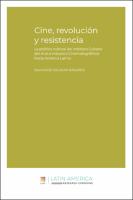Cine, revolución y resistencia
La política cultural del Instituto Cubano del Arte e Industria Cinematográficos hacia América Latina
| dc.contributor.author | Salazar Navarro, Salvador | |
| dc.date.accessioned | 2020-10-14T09:38:34Z | |
| dc.date.available | 2020-10-14T09:38:34Z | |
| dc.date.issued | 2020 | |
| dc.identifier | ONIX_20201014_9781951634094_3 | |
| dc.identifier | OCN: 1202557715 | |
| dc.identifier.uri | https://library.oapen.org/handle/20.500.12657/42583 | |
| dc.language | Spanish | |
| dc.subject.classification | thema EDItEUR::N History and Archaeology::NH History::NHK History of the Americas | en_US |
| dc.subject.classification | thema EDItEUR::A The Arts::AT Performing arts::ATF Films, cinema | en_US |
| dc.subject.classification | thema EDItEUR::1 Place qualifiers::1K The Americas::1KJ Caribbean islands | en_US |
| dc.subject.classification | thema EDItEUR::J Society and Social Sciences::JP Politics and government::JPS International relations::JPSD Diplomacy | en_US |
| dc.subject.other | Cuba | |
| dc.subject.other | Política Exterior | |
| dc.subject.other | Revolución cubana | |
| dc.subject.other | Cine latinoamericano | |
| dc.subject.other | ICAI | |
| dc.title | Cine, revolución y resistencia | |
| dc.title.alternative | La política cultural del Instituto Cubano del Arte e Industria Cinematográficos hacia América Latina | |
| dc.type | book | |
| oapen.abstract.otherlanguage | Throughout these pages a journey is made chronological by the main expressions of the cultural policy developed by the Institute Cuban Film to Latin America, from the early sixties to late 20th century. From the analysis of the Cumbite films (1964, Tomás Gutiérrez Alea), Cantata de Chile (1975, Humberto Solás), Love in the minefield (1987, Pastor Vega) and Mascaró, the American hunter (1991, Constant Rapi Diego), the highlights of this policy and the ideological projects that gave them sustenance. A set of works by Santiago Álvarez, considered the exponent most significant of documentary Cuban politics. History the relationships between ICAIC and Latin America allows us to delve into a complex reading of outer links of the Cuban Revolution, specifically what concerning the interrelationships between actors and institutions. The ultimate goal of this book is contribute to the construction of a critical account of Cuban culture after 1959, with respect to to Latin America. | |
| oapen.identifier.doi | 10.25154/book5 | |
| oapen.relation.isPublishedBy | 7bb6503b-ca4e-418b-905d-205dc2692bbb | |
| oapen.pages | 336 | |
| oapen.place.publication | Pittsburgh |

